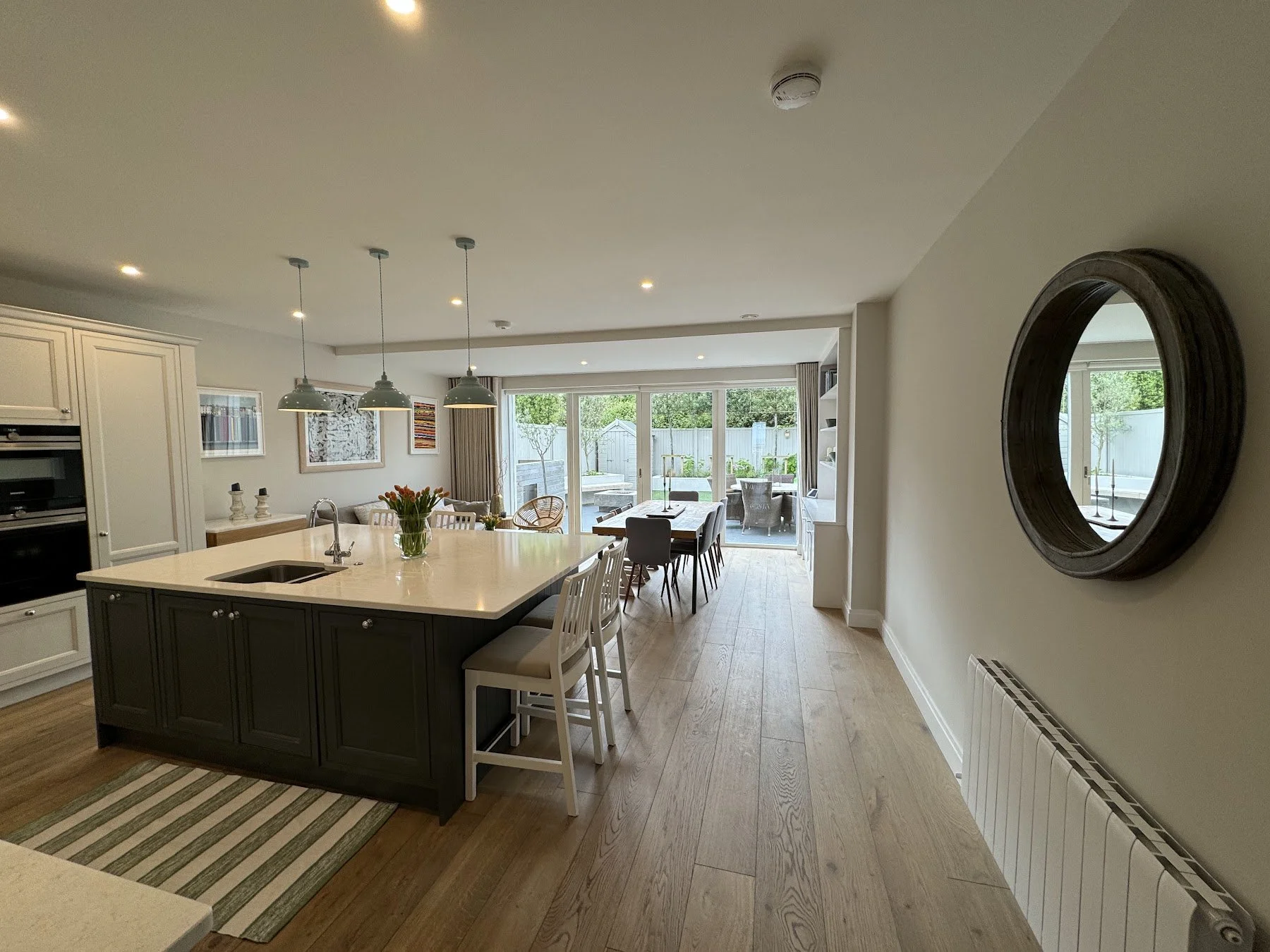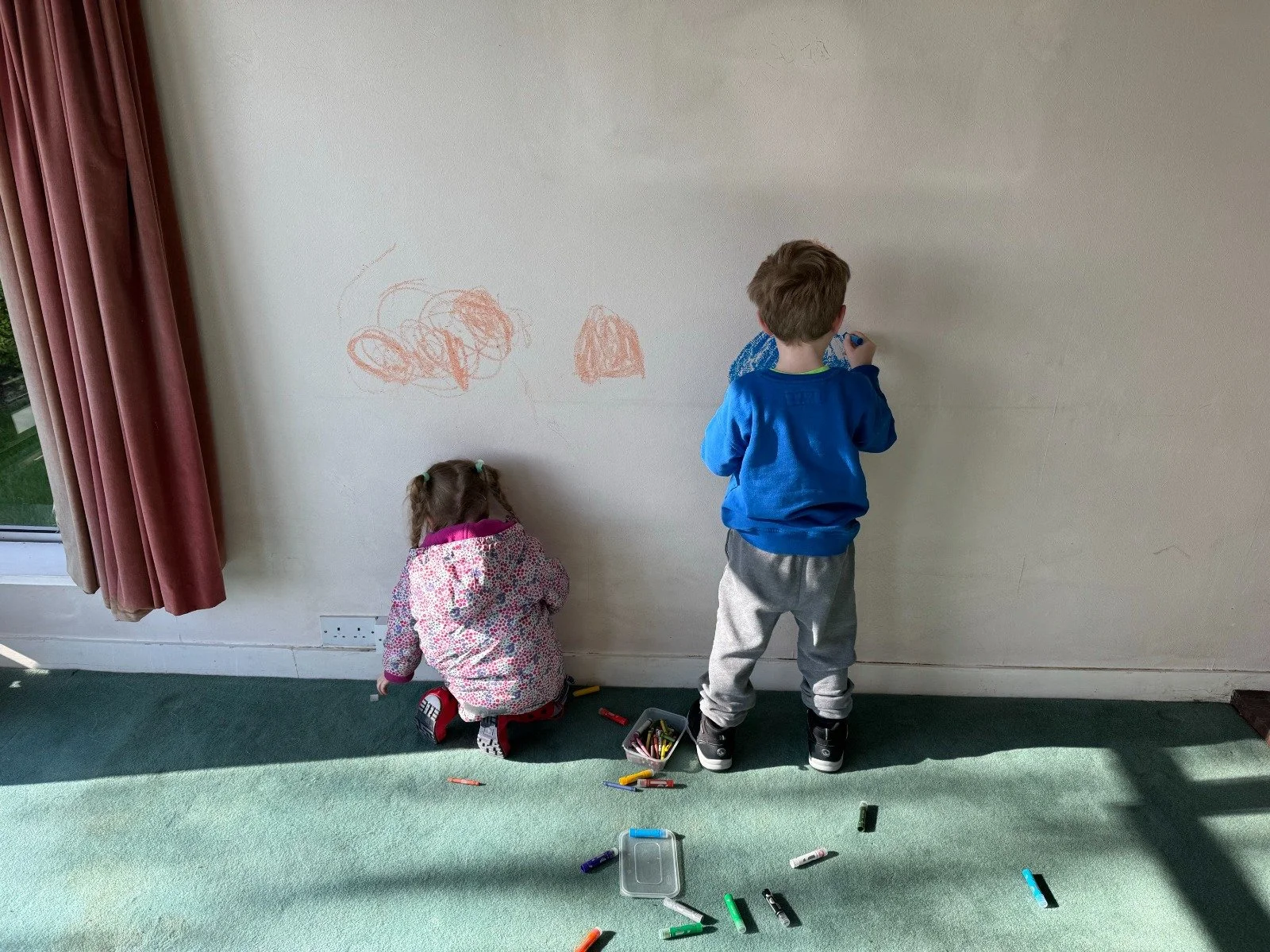Introducing Kids to a Renovation Project: Our Tips (learned the hard way)
How do you help young children understand and feel secure during a housing transition? Our journey of making our renovation project feel like a future "home" to our kids started with a few hiccups, but ended with colorful drawings on the walls (intentionally!) and a core memory made.
The Big Move
If you've been following our journey, you'll know we made the slightly unconventional decision to sell our beautiful 225 sqm A-rated home right on the seafront to become cash buyers in this wild property market. Our main motivation? A proper garden. While our previous home was stunning with those incredible sea views, what we really craved was outdoor space where the kids could run wild, where we could grow things, and where we could truly put down roots (literally and figuratively). The dream was to find the perfect renovation project – something with good bones, sea views, the potential to become our forever home, and most importantly, a generous garden that would give our family room to grow.
The kitchen in our previous home
Seven months, two fallen-through sales, and one chilly rental later, we finally found "the one" – our 1950s flat-roof architect-designed bungalow that's practically begging for a full renovation and energy retrofit.
But how do you help children understand this transition and feel secure throughout the process while creating some positive memories?
The Grand Reveal (That Wasn't So Grand)
We'd been careful about when to introduce our children to the house. After having two sales fall through, we waited until we were sale agreed before even mentioning it. We'd been building it up for weeks – focusing especially on the massive garden (our primary reason for this whole adventure), along with their new bedrooms and the playroom they'd have. We talked about planting vegetables, building tree houses, and having space for bikes and ball games – all the things that had been limited in our previous home without a proper garden.
To help prepare them for the transition, we used the Usborne First Experiences book "Moving House" as a helpful reference point. We adapted the narrative to fit our family's circumstances, which helped give them a framework to understand the process and feel secure throughout the changes.
The day we got the keys, I had it all planned out. We'd pick the kids up from school, drive to our new property, and have a little celebration – complete with 7Up and plastic cups for a proper toast to our new beginning.
It did not go as planned.
Rookie mistake number one: we didn't check the house before bringing the kids. When we arrived, we accidentally set off the alarm, and the previous owner hadn't been notified we'd closed. We had to wait in the garden while the estate agent contacted the vendor, who then came back to turn off the alarm and collect her remaining belongings.
While we explored the garden with the kids during the wait, it wasn't quite the introduction I had planned.
Take Two: Creating Magic (with Paint Sticks)
Determined not to let our first visit set the tone, I planned a do-over for the weekend. This time, I came prepared with:
- Paint sticks and chalk
- A ball for the garden
- A rope swing
- Snacks (essential)
- Toilet paper (no explanation required)
Paint sticks for decorating the walls with their artwork
I asked the kids to draw our family on the living room wall with the paint sticks.
"We're allowed to draw on the walls?" our eldest asked with surprise.
They immediately took to the idea. Suddenly, this weird old house became a place where they could do things they'd never been allowed to do before.
They created colorful figures of our family with blobby bodies and stick legs and ever optimistic - their future dog and cat.
“Quick, get started before Mum changes her mind!”
Wall art in progress
While they were drawing, I hung the rope swing from an apple tree in the garden. Even though we were months away from actually moving in, we will be working on the garden over the next few months, so this was one big request granted.
Me captured in a very flattering angle climbing the tree to hang the rope swing
We spent the rest of the afternoon exploring every corner of the house and garden. We played in their rooms, talked about color schemes, and let them decide where their beds might go. We took photos of them in different spots around the property – documentation of the "before" that we'll appreciate when we're enjoying the "after."
Lessons Learned
Our experience taught us some valuable lessons about introducing kids to a renovation project while helping them feel secure through the transition:
1. Be present and see it through their eyes
Children don't see potential the way adults do.
They can't look at a dated kitchen and envision the beautiful open-plan space it will become.
They see what's there now – not what could be. Take time to see the space through their perspective and address their immediate concerns rather than focusing only on future plans.
2. Don't expect immediate excitement
Your children might not share your vision right away, and that's okay. Give them time to warm up to the idea.
3. Let them leave their mark
If you're planning to redecorate anyway, let your children do something they wouldn't normally be allowed to do – like drawing on the walls. It helps them feel ownership of the space and creates positive associations with the new house.
4. Bring the essentials
Snacks, drinks, toilet paper, and activities are must-haves when visiting a vacant property with kids.
5. Check the property before bringing children
This one seems obvious in hindsight, but make sure any alarms are deactivated and the property is truly vacant before bringing children for their first visit.
First impressions matter, even for kids.
6. Create tangible connections to the future
Hanging the rope swing was symbolic – we won't be moving in for months, but it created a physical connection to the future we're building.
In our case, hanging that swing in the garden was particularly meaningful since having outdoor space was our main reason for selling our previous home.
Find ways to make your future plans feel real to your children now, especially by highlighting the features that motivated your move in the first place.
7. Use books to help explain the process
Children's books about moving and renovating can provide a helpful framework for kids to understand what's happening.
The Usborne First Experiences "Moving House" book worked well for us moving out of our previous home into our rental, and we have simply adapted the story to match the renovation narrative.
Looking Forward
While we won't be moving into our renovation project for many months yet, these early visits are building a foundation of security and familiarity for our children during this time of transition.
The children's drawings on our walls will eventually be covered with fresh paint, but the photos we took of their artwork will become valuable "before" documentation.
As we continue this renovation journey, we're learning that introducing children to the process is about helping them feel secure during change, creating positive associations with their future home, and involving them in meaningful ways.









